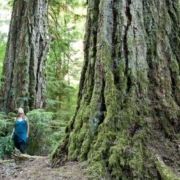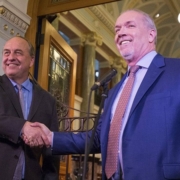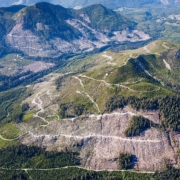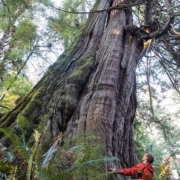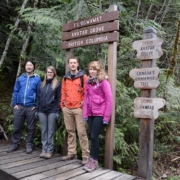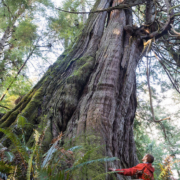Ancient Forest Alliance welcomes new BC Government and Cabinet
For Immediate Release
The Ancient Forest Alliance looks forward to working with Premier Horgan and Ministers Scott Fraser, George Heyman, and Doug Donaldson to protect BC’s endangered old-growth forests and ensure a sustainable, value-added, second-growth forest industry.
The Ancient Forest Alliance welcomes and congratulates the new British Columbia NDP government and its new cabinet after yesterday’s swearing-in ceremony at the Legislature.
The Ancient Forest Alliance is working with diverse partners to protect the province’s old-growth forests and to ensure a sustainable, value-added forest industry, and is encouraged by Premier John Horgan’s picks for several ministerial positions.
“With this new government, I believe we may be entering a period of rapid progress in environmental sustainability in this province. Green-Social Democratic governing alliances around the world, in Europe, Australia, and New Zealand in recent decades have made great strides forward in environmental and climate progress, in the expansion of renewable energy and clean tech businesses, and in social justice,” stated Ken Wu, Ancient Forest Alliance executive director. “The battle over BC’s old-growth forests has been going on for almost 50 years now and it’s time this government finally lay this issue to rest. We look forward to working constructively with this government in the months to come.”
“Old-growth forests are vital for endangered species, many First Nations cultures, tourism, the climate, clean water, and wild salmon. I think today, in 2017, if you were to ask the average British Columbian if they’d like to see our endangered old-growth forests protected while focusing on developing a sustainable, value-added, second-growth forest industry, the vast majority would agree. Most people would recognize it as a win-win proposition,” stated Andrea Inness, Ancient Forest Alliance campaigner.
Of particular interest are three new ministers who are most relevant to the Ancient Forest Alliance’s goals:
The Honourable Scott Fraser is the MLA for the riding of Alberni-Pacific, and has been appointed as the Minister of Indigenous Relations and Reconciliation. Mr. Fraser has worked hard for years to stand up for sustainable forestry jobs in BC, making it his priority to campaign for old-growth forest protection and against raw log exports and the deregulation of corporate-owned forest lands on Vancouver Island. He has advocated for the protection of local old-growth forests in the Port Alberni area, including McLaughlin Ridge, the Cameron Valley Fire Break, and Horne Mountain above Cathedral Grove. In 2013 he received the Ancient Forest Alliance’s “Forest Sustainability Award” for his great work (https://www.youtube.com/watch?v=vQbEH7u2Efc). Financial support from the province for BC’s First Nations communities for sustainable economic development and diversification, including a transition to a value-added, second-growth forest industry by the BC government, is a vital component of any policy to protect old-growth forests. Mr. Fraser’s position may facilitate such a needed policy shift.
George Heyman, the MLA for Vancouver Fairview, is now the new Minister of Environment. Heyman was previously the executive director of the Sierra Club of BC and before that was the president of the BC Government Employees Union. Heyman oversaw the Sierra Club of BC during the bulk of the organization’s negotiations with industry, First Nations, and the province regarding the Great Bear Rainforest (the province’s Central and North Coast), which resulted last year in a final agreement to protect 70% of its forests, including 85% of its old-growth forests, while providing over $120 million to First Nations communities to develop conservation-based economies linked to the increased protection. Under Heyman, the Sierra Club of BC supported the Ancient Forest Alliance’s call for the BC government to purchase and protect endangered old-growth forests on Island Timberland’s private lands on Vancouver Island, and the Sierra Club of BC has joined with 18 other organizations calling on the province to establish a land acquisition fund to protect endangered ecosystems across BC. The Ancient Forest Alliance is looking forward to working with Mr. Heyman in regards to these and other initiatives.
Doug Donaldson, the MLA for Sitkine, is now the new Minister of Forests, Lands, Natural Resource Operations and Rural Development. Thus far, Ancient Forest Alliance campaigners have not had the pleasure of meeting Mr. Donaldson, but understand that he has been involved in environmental advocacy against open netcage fish farms and hydraulic fracking in northern BC, as well as advocating for a stronger environmental impact assessment process. These are positive signs to conservationists and the Ancient Forest Alliance hopes to work closely with the new minister as the key leader who can implement the NDP’s key election promise to use the Ecosystem-Based Management model of the Great Bear Rainforest as a model for managing the province’s old-growth forests.
The Ancient Forest Alliance is excited to work with these new ministers, along with Premier Horgan himself, who during his 2011 bid for the NDP leadership made protecting old-growth forests one of his core policy planks – take note, the Ancient Forest Alliance’s Ken Wu had endorsed Horgan’s commitment to protect old-growth forests then, but not necessarily all aspects of Horgan’s platform). Horgan also joined the Ancient Forest Alliance to visit the Avatar Grove with the news media in 2010, advocating for the protection of old-growth forests in BC. See: https://www.youtube.com/watch?v=02HQc1UEWXw
The NDP’s 2017 election platform states that “In partnership with First Nations and communities, we will modernize land-use planning to effectively and sustainably manage BC’s ecosystems, rivers, lakes, watersheds, forests and old growth, while accounting for cumulative effects. We will take an evidence-based scientific approach and use the ecosystem-based management of the Great Bear Rainforest as a model.” (see page 61 of their platform at: https://action.bcndp.ca/page/-/bcndp/docs/BC-NDP-Platform-2017.pdf). If taken literally and seriously, this would almost certainly result in the protection of the remaining old growth forest on BC’s southern coast and in the BC Interior, where old-growth forests are far scarcer and more endangered than in the Central and Northern Coast (Great Bear Rainforest) where 70% of the forests and 85% of the old-growth forests were protected under the Ecosystem-Based Management plan there.
The NDP minority government has been sworn-in to replace the previously governing Liberal party after signing a governing agreement with the 3 Green Party MLAs, who have spoken with the Ancient Forest Alliance that old-growth forest protection and value-added forestry jobs will be central features of their agenda.
More Information on Old-Growth Forests
Old-growth forests are vital to sustaining unique endangered species, climate stability, tourism, clean water, wild salmon, and the cultures of many First Nations. On BC’s southern coast, satellite photos show that at least 75% of the original, productive old-growth forests have been logged, including well over 90% of the valley bottoms where the largest trees grow. Only about 8% of Vancouver Island’s original, productive old-growth forests are protected in parks and Old-Growth Management Areas. Old-growth forests – with trees that can be 2000 years old – are a non-renewable resource under BC’s system of forestry, where second-growth forests are re-logged every 50 to 100 years, never to become old-growth again.
Over the past year, the voices for old-growth protection have been quickly expanding, including numerous Chambers of Commerce, mayors and city councils, forestry unions, and conservation groups across BC who have been calling on the provincial government to expand protection for BC’s remaining old-growth forests.
BC’s premier business lobby, the BC Chamber of Commerce, representing 36,000 businesses, passed a resolution last May calling on the province to expand protection for BC’s old-growth forests to support the economy, after a series of similar resolutions passed by the Port Renfrew, Sooke, and WestShore Chambers of Commerce. See: www.ancientforestalliance.org/news-item.php?ID=1010
Both the Union of BC Municipalities (UBCM), representing the mayors, city and town councils, and regional districts across BC, and Association of Vancouver Island and Coastal Communities (AVICC), representing Vancouver Island local governments, passed a resolution last year calling on the province to protect the Vancouver Island’s remaining old-growth forests by amending the 1994 land use plan. See: https://16.52.162.165/media-release-ubcm-passes-old-growth-protection-resolution/
The Private and Public Workers of Canada (PPWC), formerly the Pulp, Paper, and Woodworkers of Canada, representing thousands of sawmill and pulp mill workers across BC, recently passed a resolution calling for an end to old-growth logging on Vancouver Island. See: https://16.52.162.165/conservationists-applaud-old-growth-protection-resolution-by-major-bc-forestry-union/
The Ahousaht First Nation north of Tofino in Clayoquot Sound recently announced that 82% of their territory will be off-limits to commercial logging. They now need provincial legislation and funding to help make their vision a reality. See: [Original article no longer available]
The Ancient Forest Alliance calling on the BC government to implement a comprehensive science-based plan to protect all of BC’s remaining endangered old-growth forests, and to also ensure a sustainable, value-added second-growth forest industry.
See maps and stats on the remaining old-growth forests on BC’s southern coast at: www.ancientforestalliance.org/old-growth-maps.php
In order to placate public fears about the loss of BC’s endangered old-growth forests, the previous BC Liberal government’s PR-spin typically over-inflated the amount of remaining old-growth forests by including hundreds of thousands of hectares of marginal, low productivity forests growing in bogs and at high elevations with smaller, stunted trees, lumped in with the productive old-growth forests, where the large trees grow (and where most logging takes place). See a rebuttal to some of the BC government’s PR-spin and stats about old-growth forests towards the BOTTOM of the webpage: https://16.52.162.165/action-alert-speak-up-for-ancient-forests-to-the-union-of-bc-municipalities-ubcm/

